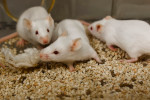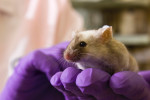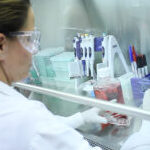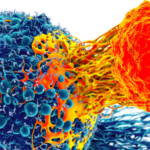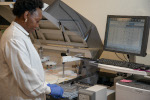Services & Products
Breeding Services
Optimize your research with tailored breeding services, providing expert care and strategic support for your mouse colonies with the Mouse Biology Program. Our Breeding Services provide comprehensive support for propagating and maintaining genetically modified mouse colonies. From routine breeding to complex genetic crosses, we offer…Read more
Colony Management
Ensure the success of your research with expert colony management services, offering comprehensive care and customized solutions for your mouse models with the Mouse Biology Program. The Mouse Biology Program provides customized colony management services to support your research efficiently and effectively. Our team handles…Read more
Cryogenic Services
The Mouse Biology Program has decades of expertise in cryopreservation and recovery of mouse sperm and embryos, ensuring reliable preservation and recovery to support your colony management needs. Our Cryogenic Services are critical for maintaining and recovering valuable genetic lines, ensuring research continuity and long-term…Read more
Data Analysis Services
Enhance your research outcomes with data analysis services, offering expert interpretation and streamlined insights for your studies with the Mouse Biology Program. The Mouse Biology Program’s Bioinformatics and Analytics team excels at converting complex mouse model data into clear, actionable insights. With a deep understanding…Read more
Experimental Design Services
Optimize your experimental design with the Mouse Biology Program, guiding your project from initial concept to publication. Our Experimental Design Services provide researchers with comprehensive support in developing scientifically rigorous and robust studies using mouse models. Leveraging our deep expertise in genetics, phenotyping, and data…Read more
Molecular Constructs
Advance your research with molecular construct services, providing precise design and development of genetic tools for your studies with the Mouse Biology Program. The Mouse Biology Program provides advanced molecular construct services to support your research with precision and reliability. Using cutting-edge techniques—including CRISPR gene…Read more
Mouse Biology Shared Resource
The goal of Mouse Biology Shared Resource is to meet the needs of UC Davis Comprehensive Cancer Center investigators, utilizing genetically-altered mice for basic, clinical and translational research. The Mouse Biology Shared Resource offers many services Mouse Model Creation Services (generation of knockout and transgenic…Read more
Mouse Model Creation
Bring your research to life with mouse model creation services, offering customized and precise genetic engineering to develop models tailored to your study needs with the Mouse Biology Program. Genetically modified mice are primarily created through two complementary approaches: targeted integration and random DNA integration.…Read more
Pathology Services
The Mouse Biology Program’s expert pathology services deliver unparalleled insights into disease mechanisms and genetic modifications, empowering groundbreaking research. The Mouse Biology Program offers comprehensive pathology services to support in-depth analysis of your mouse models. Our experienced team provides detailed assessments, including gross and histopathological…Read more
PDX Services
Accelerate cancer research with Patient-derived xenograft (PDX) models, providing patient-derived xenografts for studying tumor biology and testing therapies with the Mouse Biology Program. The Mouse Biology Program specializes in rapidly creating patient-derived xenograft (PDX) models using freshly harvested and frozen tumors. These tumors can be…Read more
Phenotyping Services
Ensure the highest standards of care with vivaria services, providing expertly managed environments and comprehensive support for your research animals with the Mouse Biology Program. The Mouse Biology Program (MBP) provides comprehensive phenotyping services to support diverse research needs. Our offerings include morphological, metabolic, behavioral,…Read more
Quality Control Services
The Mouse Biology Program ensures your research's precision, reliability, and integrity with comprehensive quality control services, delivering the accuracy and confidence you need for successful outcomes. The Mouse Biology Program offers comprehensive quality control services designed to uphold the integrity and reliability of your mouse…Read more
Reproductive Services
MBP’s Reproductive Services ensure efficient breeding, maintenance, and preservation of valuable mouse lines, helping researchers sustain their colonies and advance studies without delays. The Reproductive Services at the Mouse Biology Program (MBP) are designed to enhance the efficiency and success of your mouse colony management.…Read more
Research Administration & Support
The Mouse Biology Program offers comprehensive support to streamline research. With a focus on precision, efficiency, and regulatory compliance, our expert team ensures seamless operations, allowing you to focus on advancing your discoveries with confidence. The Mouse Biology Program, Research Administration & Support Services offer…Read more
Vivaria Services
Ensure the highest standards of care with vivaria services, providing expertly managed environments and comprehensive support for your research animals with the Mouse Biology Program. Our Vivaria Services offer state-of-the-art facilities and unparalleled expertise to ensure the health and well-being of your mouse colonies. Designed…Read more
